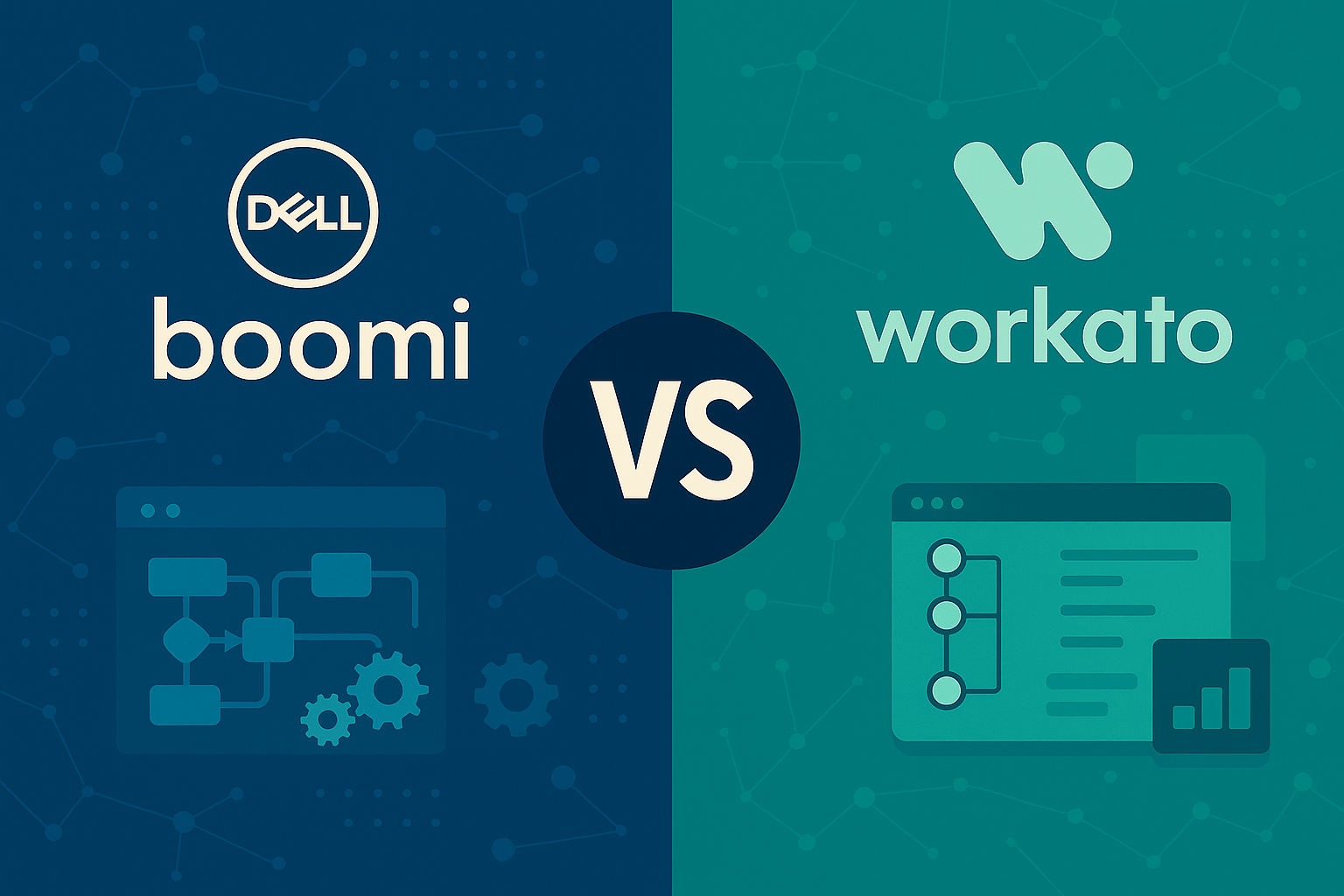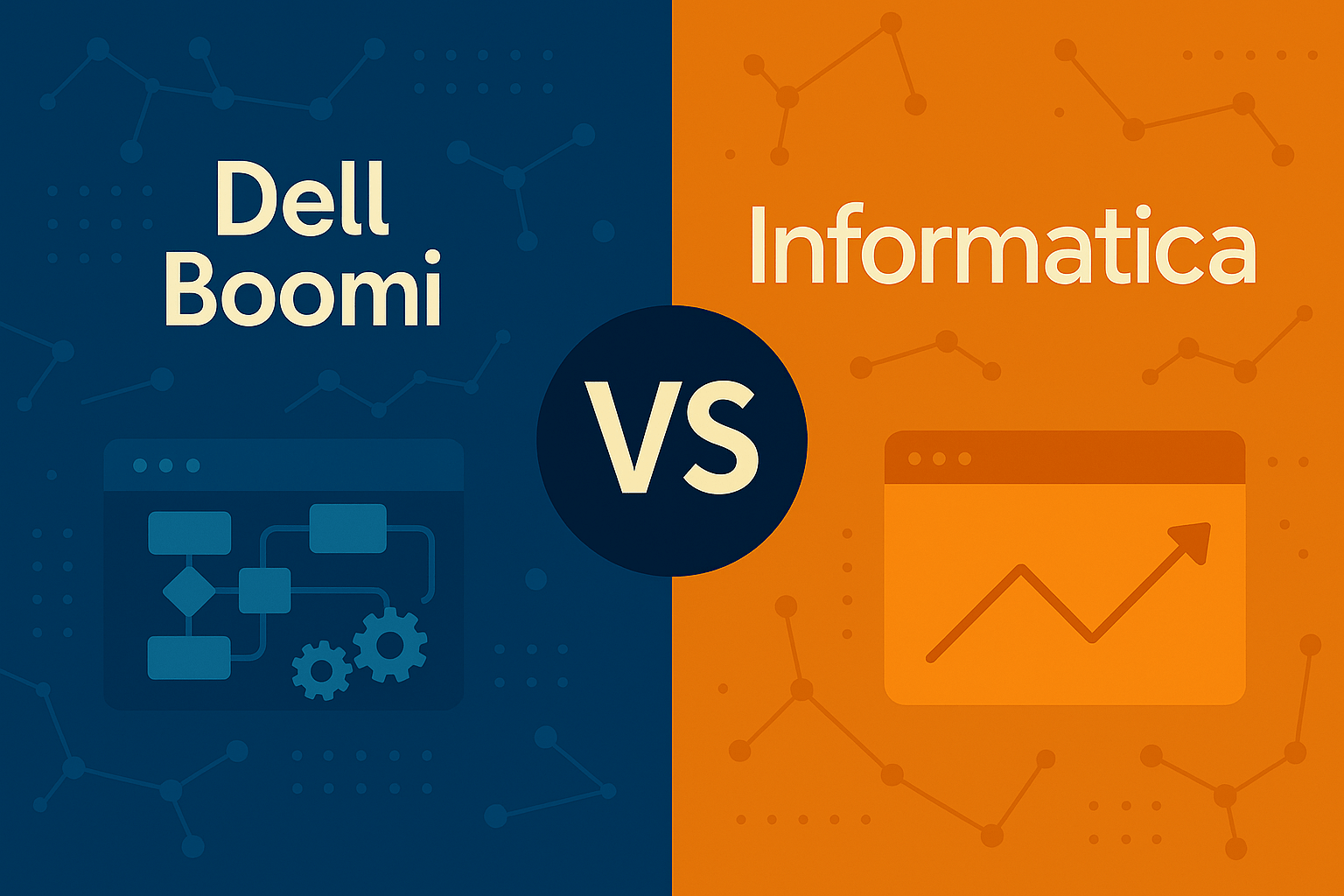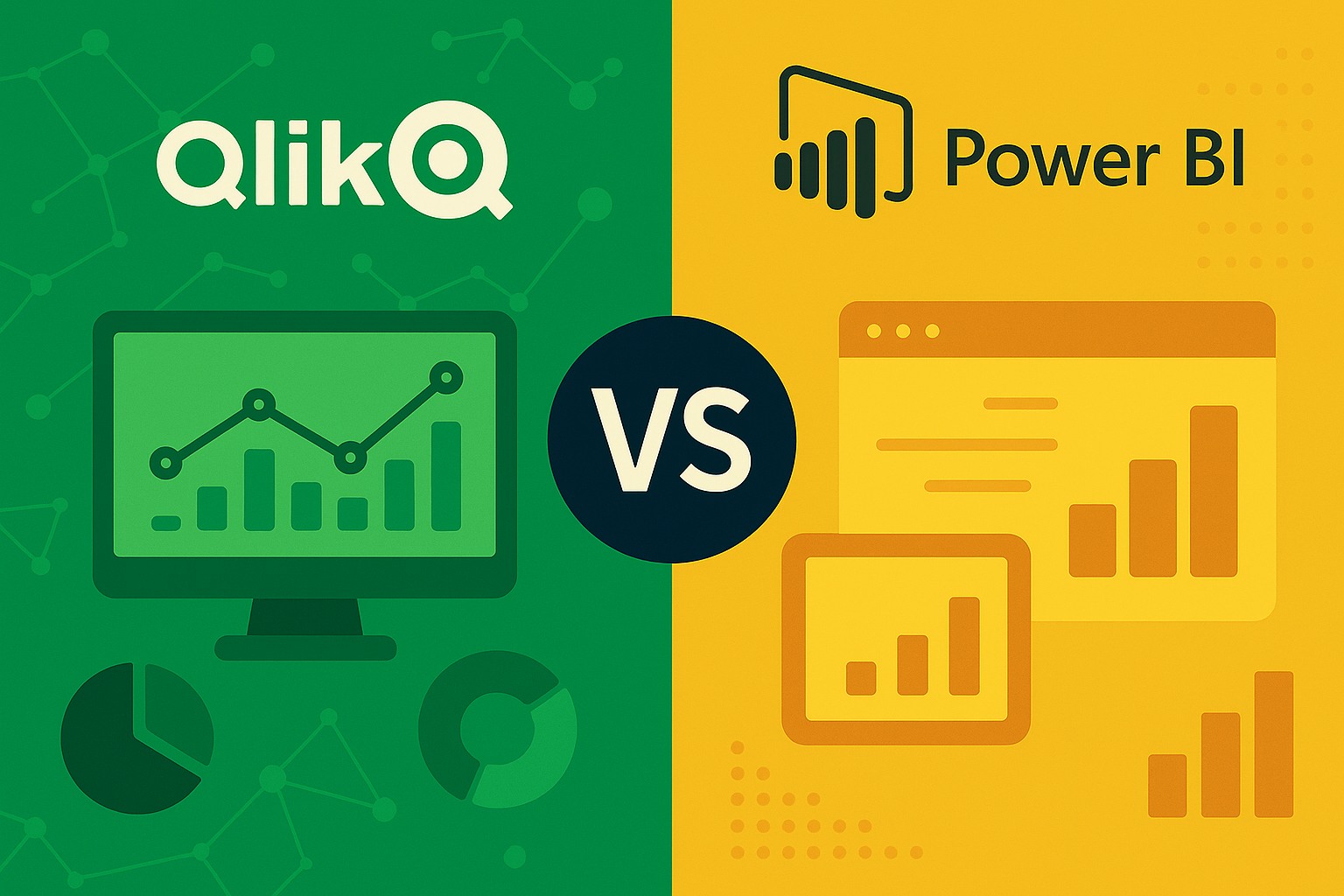Dell Boomi vs Jitterbit: Which Integration Platform is Right for You?
Choosing the right integration platform can transform your business operations—or create costly bottlenecks that slow everything down.
This comprehensive comparison will help you understand the key differences between Dell Boomi and Jitterbit to determine which solution aligns best with your specific integration requirements.
Data Tool Comparison
|
Category |
Factory Thread |
Dell Boomi |
Jitterbit |
|---|---|---|---|
|
Core Focus |
Real-time integration for manufacturing operations |
Enterprise-grade integrations with control and scale |
Rapid deployment for cloud-first, mid-size enterprises |
|
Best For |
Manufacturers needing OT/IT convergence and edge deployment |
Large enterprises with complex hybrid infrastructure |
Medium-sized orgs seeking quick, low-code cloud integrations |
|
Pre-built Connectors |
MES, PLCs, SCADA, ERP (Rockwell, Siemens, SAP) |
200+ connectors across on-prem and cloud |
Extensive templates and connectors for cloud apps |
|
Interface |
No-code visual builder for operational teams |
Visual builder with advanced scripting |
Drag-and-drop low-code UI for fast workflows |
|
AI Features |
AI-generated workflows and industrial logic prompts |
Limited/none |
Template-based setup, no AI assistant |
|
Deployment Options |
Edge-ready, on-prem, cloud with offline support |
Cloud, on-prem, hybrid via AtomSphere |
Cloud-first with optional private agents |
|
Real-Time Capability |
Native event-based triggers (machine states, shift changes) |
Real-time sync for enterprise workflows |
Best for cloud-to-cloud sync, less for OT systems |
|
Offline Execution |
Yes – workflows execute on edge even without connectivity |
No – needs active Atom connectivity |
Limited – cloud reliant for most functions |
|
Master Data Management |
Federated operational layer without duplication |
Native MDM hub |
Not a core focus – partner dependent |
|
API Management |
REST, GraphQL, OData endpoint support |
Full lifecycle API governance |
Built-in portal, simpler governance model |
|
Monitoring & Observability |
Unified dashboards, anomaly alerts, flow tracking |
Version control, workflow monitoring |
Visual logs, user-friendly dashboards |
|
Learning Curve |
Minimal for engineers – OT-friendly UX |
Steep for complex enterprise setups |
Very low – business user friendly |
|
Cost Structure |
Flexible, scaled for industrial use cases |
Subscription-based, ~$20K–$100K/yr for enterprise |
Starts ~$450/mo, scales with usage |
|
Use Case Strength |
MES-to-ERP sync, real-time alarms, shop floor automation |
Multi-system enterprise integrations, B2B/EDI |
Quick cloud app integrations, SaaS orchestration |
|
Scalability |
High – scales horizontally with edge nodes |
High – supports large data volumes |
Good for mid-sized workloads, cloud-based only |
What Makes These Integration Platforms Unique?
Dell Boomi – Enterprise-Grade Control

Dell boomi excels in complex enterprise environments where comprehensive control and extensive functionality matter most. Built on the AtomSphere platform, this integration solution leverages distributed Atom engines that can be deployed across cloud, on premise, and hybrid environments, providing seamless connectivity for even the most demanding integration scenarios.
Key benefits of Dell Boomi:
-
Complete api management lifecycle from creation to retirement
-
Master data hub capabilities for enhanced data quality and governance
-
Extensive pre built connectors (200+ applications) covering both mainstream and niche enterprise systems
-
Enterprise-scale B2B/EDI functionality crucial for supply chain operations
-
Powerful data transformation capabilities with advanced scripting support
-
Robust solutions for managing integrations across multiple systems
Dell boomi offers a comprehensive suite of features that support complex integrations requiring significant technical expertise. The platform’s cloud native architecture combined with flexible deployment options makes it particularly valuable for large organizations managing various platforms and data sources.
Jitterbit – Rapid Deployment Excellence

Jitterbit focuses on rapid deployment capabilities and user friendly interface design, making it an attractive alternative or complementary solution for organizations prioritizing speed and ease of use. The Harmony platform emphasizes intuitive design and quick setup, enabling both technical and non technical users to create effective integration processes.
Key benefits of Jitterbit:
-
User friendly drag and drop interface that minimizes the steeper learning curve
-
Rapid deployment with typical implementation cycles of 2-4 weeks
-
Intuitive interface for visual data mapping and transformation
-
Cost effective alternative with cloud-first architecture
-
Low code interface that empowers various services teams
-
Quick deployment capabilities that accelerate time-to-value
Jitterbit’s platform offers a valuable addition to organizations seeking seamless integration without extensive technical overhead. The platform depends on simplifying complex integrations through pre built templates and an intuitive design that supports rapid deployment.
Dell Boomi vs Jitterbit Integration: What’s the Difference?

Platform Architecture
The fundamental architectural differences between these integration solutions significantly impact deployment flexibility and operational efficiency.
Dell Boomi operates through its AtomSphere cloud platform, utilizing distributed Atom engines that function as lightweight runtime environments. These Atoms can be strategically deployed wherever connectivity is needed—whether in cloud environments, on premise data centers, or hybrid configurations. This architecture enables smooth data flow across complex enterprise landscapes while maintaining centralized management and version control.
Jitterbit employs the Harmony platform as a service model, primarily designed for cloud-first deployments with optional private agents for hybrid connectivity. While this approach streamlines implementation for cloud native architecture scenarios, some advanced features remain cloud-dependent, which may limit flexibility for organizations with significant on premise infrastructure.
Complexity Handling
The platforms diverge significantly in their approach to handling integration complexity and supporting different user types.
Dell Boomi specializes in advanced enterprise scenarios requiring sophisticated business processes, extensive workflow automation, and comprehensive data integration across various systems. The platform excels in environments demanding master data management, complex B2B/EDI transactions, and integration scenarios involving legacy systems with specific integration needs.
Jitterbit targets streamlined cloud integrations where rapid deployment and minimal technical complexity take priority. Its drag and drop interface and low code approach make it particularly suitable for medium sized enterprises and teams seeking quick setup without extensive technical expertise requirements.
Pricing Structures and Investment Considerations
Understanding the financial implications helps organizations align platform selection with budget constraints and expected data volume.
Dell Boomi pricing follows a subscription based model starting at approximately $550 monthly for connector-based licensing. Enterprise deployments typically range from $20,000 to $100,000+ annually, depending on integration goals, data volume, and advanced features required. The platform’s comprehensive capabilities justify higher investment for organizations with complex integration needs.
Jitterbit offers a Cloud Starter package beginning around $450 monthly, with consumption-based scaling for larger deployments. While entry-level pricing appears competitive, costs can increase significantly as organizations scale their integration processes or require additional features. Annual subscriptions for substantial implementations may reach $25,000+ depending on specific business requirements.
Learning Curve and Implementation Timeline
The time investment required for successful platform adoption varies considerably between these solutions.
Dell Boomi presents a steeper learning curve, particularly for advanced configurations requiring custom scripting or complex data transformation. Implementation cycles typically span 4-8 weeks or longer for sophisticated projects. Organizations should plan for adequate technical expertise and potential training investments to maximize platform value.
Jitterbit minimizes coding knowledge requirements through its intuitive design and pre built templates. Most integration scenarios can be implemented within 2-4 weeks, enabling organizations to achieve operational efficiency improvements more quickly. This rapid deployment approach particularly benefits teams with limited technical resources or urgent integration deadlines.
What Experienced Users Say
User feedback from community forums and review platforms reveals consistent patterns in platform satisfaction and challenges.
Dell Boomi User Experiences
Dell Boomi enthusiasts value:
✅ Comprehensive enterprise capabilities supporting complex business operations
✅ Advanced master data management and data quality features
✅ Extensive B2B/EDI functionality for supply chain integration
✅ Robust version control and workflow automation capabilities
✅ Platform’s ability to handle high data volume and multiple data sources
Common challenges mentioned:
-
Initial learning curve for non-technical team members
-
Higher implementation costs for basic integration scenarios
-
Complexity that may exceed requirements for straightforward projects
Jitterbit User Feedback
Jitterbit users appreciate:
✅ Rapid deployment speeds that accelerate project timelines
✅ Intuitive user interface requiring minimal technical training
✅ Cost effective implementation for medium sized enterprises
✅ Strong support for automating workflows between cloud applications
✅ Quick setup process that delivers immediate value
Limitations noted:
-
Advanced customization capabilities more limited than enterprise-grade alternatives
-
Scalability considerations for very large or complex deployment scenarios
-
Some advanced features restricted to cloud-only deployments
Integration Requirements Overview
Selecting the right platform requires honest assessment of your organization’s specific integration landscape and future growth plans.
Dell Boomi Ideal Scenarios
Choose Dell Boomi when you need:
-
Complex enterprise scenarios involving multiple legacy systems and modern applications
-
Comprehensive master data management with stringent data quality requirements
-
Extensive B2B/EDI functionality for supply chain or partner integrations
-
Advanced workflow automation supporting sophisticated business processes
-
Hybrid deployment flexibility combining cloud and on premise infrastructure
-
Integration platform capable of managing high data volume and complex data migration projects
Dell Boomi particularly suits large enterprises, regulated industries, and organizations where api management, data governance, and audit capabilities are mission-critical for business operations.
Jitterbit Optimal Use Cases
Choose Jitterbit when you prioritize:
-
Rapid deployment with minimal technical complexity
-
User friendly interface for non technical users and citizen integrators
-
Cost effective alternative for straightforward cloud integration scenarios
-
Quick deployment capabilities for time-sensitive projects
-
Low code solution supporting various services without extensive development resources
Jitterbit works exceptionally well for cloud-first organizations, SaaS companies, and medium sized enterprises seeking efficient integration solutions without extensive technical overhead.
Which Integration Platform is Right for You?
The decision between these integration platforms ultimately depends on balancing your organization’s technical requirements, timeline constraints, and long-term integration strategy.
Choose Dell Boomi if you want:
✔ Enterprise-scale integration capabilities with comprehensive feature depth
✔ Advanced master data management and data quality controls
✔ Extensive B2B/EDI functionality supporting complex supply chains
✔ Hybrid deployment flexibility for diverse infrastructure environments
✔ Platform as a service solution with extensive technical customization options
Choose Jitterbit if you want:
✔ Rapid deployment and implementation minimizing time-to-value
✔ User friendly interface accessible to non technical users
✔ Cost effective cloud integration without complex enterprise requirements
✔ Quick setup supporting immediate operational efficiency improvements
✔ Complementary solution for organizations with straightforward integration goals
Making Your Final Decision
Both dell boomi and Jitterbit can deliver successful integration outcomes when properly matched to organizational needs. The right platform choice depends on honestly evaluating your integration complexity, available technical expertise, timeline requirements, and budget constraints.
For enterprise control and comprehensive capabilities, Dell Boomi provides the depth and flexibility needed for complex integration scenarios involving disparate systems and sophisticated business processes.
For rapid deployment and user-friendly operation, Jitterbit offers an accessible solution that enables quick wins while supporting essential data migration and workflow automation needs.
Critical Success Factor: Regardless of platform selection, invest time in thorough technical assessment and proper planning. Both solutions require careful consideration of your integration needs, data sources, and long-term scalability requirements to ensure optimal return on investment.
Consider conducting proof-of-concept projects with your preferred platform to validate compatibility with your specific technical environment and integration goals before committing to full implementation.
Factory Thread: Built for Real-Time Industrial Integration
Boomi offers comprehensive control. Jitterbit delivers rapid deployment. But both are built with traditional IT-centric architectures. Factory Thread provides a third option—an integration platform designed specifically for manufacturing operations and real-time industrial data.
Factory Thread doesn’t just connect cloud apps—it’s built to unify shop floor systems, operational data, and production workflows across MES, PLCs, ERPs, and IoT. For manufacturers, it offers native compatibility with industrial protocols and edge deployment capabilities where latency, reliability, and data fidelity are critical.
Why Manufacturers Choose Factory Thread:
-
No-Code Workflows for Industrial Engineers: Drag-and-drop interface optimized for operations teams, not just developers or IT.
-
Native OT System Integration: Built-in support for Rockwell, Siemens, OPC UA, MQTT, and manufacturing protocols—no custom adapters required.
-
Edge Execution and Offline Resilience: Run workflows directly on industrial gateways with offline support for disconnected environments.
-
Real-Time Event Triggers: Automate based on machine states, alarms, shift changes, or sensor anomalies—not just data arrival.
-
Complete Observability: Monitor, audit, and alert across operational systems without centralized data duplication.
Factory Thread fills the gap left by horizontal iPaaS tools—delivering the control needed for real-time manufacturing without compromising speed or simplicity. If your “integration challenge” includes downtime events, machine-to-cloud coordination, or scheduling sync between ERP and MES, Factory Thread is purpose-built to solve it.
Share this
You May Also Like
These Related Stories

Boomi vs Workato: Which iPaaS Platform is Right for You?

Boomi vs Informatica: Which Integration Platform is Right for You?



No Comments Yet
Let us know what you think